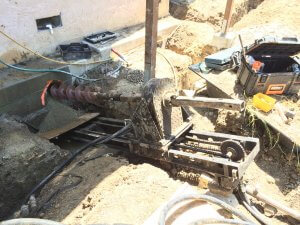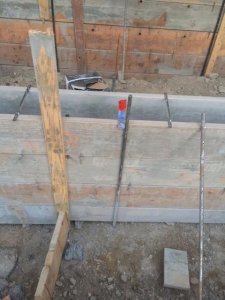Seismic Retrofiting
 Retrofit stabilizes a building by reinforcing and bolting together its understructure. A house’s understructure is composed of four main parts: the foundation, the sill plate, the pony wall, and the floor framing. Each of these components could endanger the rest of the house if not properly secured.
Retrofit stabilizes a building by reinforcing and bolting together its understructure. A house’s understructure is composed of four main parts: the foundation, the sill plate, the pony wall, and the floor framing. Each of these components could endanger the rest of the house if not properly secured.
Foundation
The foundation is a building’s basic support. Most foundations are solid flats of concrete. A building will not be structurally secure in a serious earthquake unless the components of its understructure (the sill plate and/or pony wall) have been properly bolted to this concrete foundation. In the worst case scenario, an improperly secured house will be jarred off of its foundation in a severe earthquake. This damage is almost always irreparable.
Some foundations are made of cinder blocks, hollow concrete blocks that generally haven’t been reinforced to withstand the side-to-side (shear) motion of an earthquake. Cinder blocks can shift or collapse under shear stress, sending a house toppling.
Some older homes may have brick foundations, which are particularly vulnerable because of mortar’s instability. It is less expensive to have a foundation retrofit than to have it replaced— call us to learn more.
Sill Plate
The sill plate is the 2×4 or 2×6 wood flat that covers the concrete foundation and connects it to the pony wall (or, if the house doesn’t have a pony wall, to the floor framing). If the sill plate hasn’t been anchored to the foundation, it can become the weak point where a house can be jolted from its understructure and severely damaged.
 Pony Wall
Pony Wall
A pony wall, also called a cripple wall, is a plywood-enforced wall that rests on top of the sill plate, supporting the floor framing and the rest of the house. The walls of a house’s bottom floor (generally the basement) are usually pony walls. Many single-floor houses have no pony wall, and the sill plate connects directly to the floor framing instead.
The main weakness in a pony wall is a lack of shear (horizontal) support—it doesn’t have enough plywood bracing to stabilize it against an earthquake’s horizontal rocking. Even houses with some shear support may not have enough to be safe.
Floor Framing
Floors are supported by a parallel series of wooden joists that range in size from 2×6 to 2×12. In most homes, these joists are connected at the ends by a perpendicular board (called the rim joist), which strengthens the network of boards. Older homes sometimes lack this beam, and plywood must be placed between the joists to increase their strength and allow for bolting to the pony-wall or sill-plate. Floors that do have a rim joist may still be in danger of being jolted from their understructure, since often the rim joist is inadequately secured to the wall (or sill plate) beneath.
Your house may have an unconventional understructure that doesn’t match these descriptions. If so, it can still be retrofit, but the retrofit will require special engineering to ensure that the structure is reinforced correctly.












